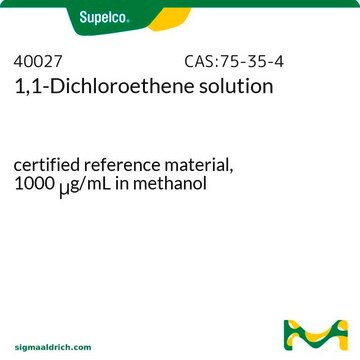40010-U
1,1,1-Trichloroethane solution
certified reference material, 5000 μg/mL in methanol
Sinonimo/i:
Methyl chloroform
About This Item
Prodotti consigliati
Grado
certified reference material
TraceCERT®
Nome Commerciale
TraceCERT®
CdA
current certificate can be downloaded
Confezionamento
ampule of 1 mL
Concentrazione
5000 μg/mL in methanol
tecniche
HPLC: suitable
gas chromatography (GC): suitable
applicazioni
environmental
Formato
single component solution
Temperatura di conservazione
2-8°C
InChI
1S/C2H3Cl3/c1-2(3,4)5/h1H3
UOCLXMDMGBRAIB-UHFFFAOYSA-N
Cerchi prodotti simili? Visita Guida al confronto tra prodotti
Applicazioni
Altre note
Note legali
Avvertenze
Danger
Indicazioni di pericolo
Consigli di prudenza
Classi di pericolo
Acute Tox. 3 Dermal - Acute Tox. 3 Inhalation - Acute Tox. 3 Oral - Flam. Liq. 2 - Ozone 1 - STOT SE 1
Organi bersaglio
Eyes,Central nervous system
Codice della classe di stoccaggio
3 - Flammable liquids
Classe di pericolosità dell'acqua (WGK)
WGK 2
Punto d’infiammabilità (°F)
51.8 °F - closed cup
Punto d’infiammabilità (°C)
11 °C - closed cup
Dispositivi di protezione individuale
Eyeshields, Faceshields, Gloves, type ABEK (EN14387) respirator filter
Scegli una delle versioni più recenti:
Possiedi già questo prodotto?
I documenti relativi ai prodotti acquistati recentemente sono disponibili nell’Archivio dei documenti.
I clienti hanno visto anche
Protocolli
US EPA Method 8260: GC Analysis of Volatiles on SPB®-624 after Purge & Trap using "K" Trap, Fast GC Analysis
Il team dei nostri ricercatori vanta grande esperienza in tutte le aree della ricerca quali Life Science, scienza dei materiali, sintesi chimica, cromatografia, discipline analitiche, ecc..
Contatta l'Assistenza Tecnica.












